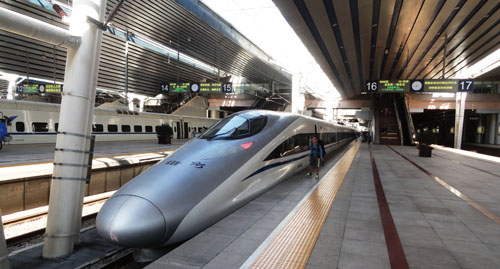
You might be surprised to find that China’s rail and road network are a huge improvement over long-distance travel options in your home country. They offer an affordable, comfortable, and often faster alternative to air travel or driving, especially in spring and summer when the weather can delay flights between Beijing and major domestic and international destinations.
In fact, Beijing Capital International Airport (BCIA) earned the ignominious title of “the World’s Most Delayed Airport” in July 2013, with an on-time rate of only 18 percent. Couple that with higher plane ticket prices and train travel becomes the clear choice.
Long-distance bus travel is a less expensive option and may be a better method of transportation for harder-to-reach areas. For example, rural towns or destinations far off the beaten path may only be accessible by bus. Far from the rickety sardine cans of decades past, modern bus travel in China can be perfectly acceptable as long as you adjust your expectations.
The biggest challenge for non-Chinese speakers will be purchasing bus and train tickets as well as knowing which station to get off at, assuming you’re not traveling to the end of the line.
Plane or Train?
The establishment of the high-speed train service from Beijing to Shanghai was a boon for many travelers, from nervous flyers to businesspeople who needed to know when they would arrive at their destination. When time is of the essence, train travel may be the way to go – but not always.
On average (assuming that the flight takes off on time), taking the plane from Beijing to major domestic destinations will always be the faster option. Shanghai’s Hongqiao International Airport and Hongqiao Train Station are right next to each other, so there’s no difference in time from either of those places to the city center.
In Beijing, all high-speed trains for Shanghai and Tianjin depart from Beijing South Railway Station. The station is about the same distance from the central business district as BCIA. If you compare travel times for the plane (just over 2 hours) and the high-speed train (4.5 hours) to Shanghai, the plane wins every time.
However, given that 80 percent of the nation’s airspace is reserved for military use and conservative air traffic controllers regularly delay flights due to factors like pollution, snow, and thunderstorms, the train is a safer bet.
In addition, flying from Beijing to Shanghai takes you from the world’s most delayed airport to the world’s second most delayed airport. Knowing exactly what time the train will arrive and depart is a huge advantage. Add to that cleanliness and lots of legroom, and rail travel starts to look pretty good.
Get on the Train and Go
Beijing has three train stations: Beijing Railway Station southwest of Jianguomen, Beijing West Railway Station in Xizhimen, and Beijing South Railway Station in Fengtai District. The first offers access to international destinations such as Mongolia, Russia, and even North Korea; domestic trains are generally slower. The second generally offers high-speed trains to destinations west of Beijing. The third offers the fastest trains to Shanghai and Tianjin, as well as slower trains to major cities in southern China.
Each train has two to three classes: business class (무蛟된), first class (寧된), and second class (랗된). Business class isn’t available on every train. Second class – the most common – has seating configurations of three seats to one side of the aisle and two to the other. Each seat reclines and comes with a meal tray. There are two electrical outlets in most rows for the side with three seats and one for the side with two seats, though Wi-Fi is not yet available. First class has fewer, larger seats that include some complimentary food and beverage. Business class has a small number of semi-private compartments that come with higher-quality food and drink.
Second-class tickets cost less than the average air ticket while first-class tickets cost about the same as a full-fare air ticket. Business class tickets are between the price of a full-fare economy plane ticket and a business class plane ticket.
Trains and train numbers are not interchangeable. Train routes that begin with the letter G are the fastest and stand for gaotie (멕屆). Train routes prefaced with the letter D are the next fastest and stand for dongche (땡났). Beyond that, rail travel will likely be much slower than your average foreign passenger would expect or hope (see sidebar for an explanation of train letters).
One of the biggest disadvantages of train travel is that tickets may only be purchased ten days before the intended departure date. This is particularly tricky during peak travel periods such as Spring Festival and the National Day holiday in October, as tickets sell out quickly and train stations are jammed with people rushing home for the break.
All purchases of train tickets in China now require photo identification. The document must be produced at the time of purchase; sometimes tickets can be reserved in advance but must be picked up by the user with a valid photo ID. Generally, this also means you can’t buy tickets on someone else’s behalf. You can sometimes talk the clerk into taking a photocopy of your passport or allowing you to buy tickets for a friend, but there’s no way to predict. In addition, this would only work at individual ticketing agencies and not at the train station.
Tickets can be purchased in person at a train station, at one of Beijing’s many authorized ticket offices, or online. The official website for buying train tickets is www.12306.cn (Chinese only). Those who can’t read Chinese can buy tickets via Ctrip (english.ctrip.com), which charges a service fee. Note that each of the city’s train stations offers at least one queue labeled with an English sign and staffed by an English-speaking clerk. That being said, purchasing tickets at the train station tends to be an inconvenient and frustrating experience.
One piece of advice: Pack your own food. While the level of service is generally quite good, the catering is still lacking. South Railway Station has about 20 different Chinese and international fast food chains; you can bring your own food from home or outside the station, but not beverages. Liquids may be confiscated during the security check, which all passengers must go through upon entering the station.
Taking the Bus
Fewer foreigners take the bus for long-distance travel in China, especially after the introduction of high-speed rail travel. However, some destinations aren’t conveniently served by air or train, making the bus most convenient.
Buses to domestic destinations leave from long-distance bus stations. Beijing has about 20 different long-distance bus stations – some with overlapping destinations – but they generally serve cities relative to their location from Beijing. In short, buses from stations located in the west of the city will travel west, buses in the north will travel north, and so on. The largest station is Zhaogongkou Long-Distance Bus Station in Fengtai District, near the South Third Ring Road.
A list of bus destinations and schedules can be found at www.piaojia.cn, but tickets must be purchased in person. Advance purchase will depend on the destination and the station. Overnight sleeper buses – buses with sleeping berths – are available for journeys of ten hours and more. They won’t be particularly comfortable but are relatively inexpensive.
What Do All Those Train Letters Mean?
Research by Morgan Shang
Letters are used to prefix different train routes, denoting train type and speed. Besides the two most commonly used by foreigners – D and G – there’s a whole alphabet soup of other categories that can be confusing for even the most seasoned travelers. Here’s a simple breakdown.
• G is for gaotie (高铁): Trains that travel at speeds of over 300km/hour. The fastest type of train, which travels on an exclusive high-speed rail network.
• D is for dongche (动车): Trains that travel at speeds of over 200km/h. The second fastest type of train.
• T is for tekuai (特快): Translates to “very fast,” but is ironically the second slowest type of train.
• K is for pukai (普快): Translates to “ordinary speed.” The slowest type of train.
• Z is for zhida (直达): Translates to “express train.” Unlike other trains, which stop at several stations along the way, this type goes straight from point A to B to save time.
• L is for linshi (临时): Translates to “temporary.” Denotes trains added to ease congestion in times of peak travel, such as Spring Festival and National Day.
You may also encounter the term chengji (城际). These inter-city trains serve those who frequently commute between two major neighboring cities, such as Beijing and Tianjin, Guangzhou and Shenzhen, or Shanghai and Hangzhou. They run frequently and usually carry the letter prefix D or G. However, the chengji distinction makes no practical difference when purchasing train tickets.
This article originally appeared in the beijingkids Home & Relocation Guide 2014. To get your free copy, email distribution@truerun.com or view it online at Issuu.
Photo courtesy of Fabio (flickr)



